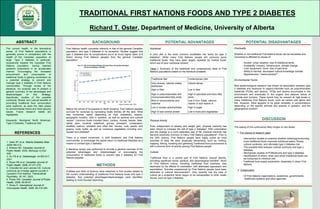
Traditional First Nations foods and type 2 diabetes
- 1. f TRADITIONAL FIRST NATIONS FOODS AND TYPE 2 DIABETES g Richard T. Oster, Department of Medicine, University of Alberta k ABSTRACT The current health, in the biomedical sense, of First Nations populations is generally poorer in comparison with the health of the Canadian population at large. Type 2 diabetes in particular, excessively impacts the Canadian First Nations population, having reached epidemic proportions in an accelerated manner. Encouraging the increased procurement and consumption of traditional foods is gaining momentum as a potential strategy to prevent and manage type 2 diabetes in First Nations communities. Through review of the literature, our purpose was to present a general summary of the advantages and disadvantages of this strategy. Specifically, studies of the possible nutritional, fitness, and cultural benefits of promoting traditional food consumption were explored, as were the risks posed by environmental toxins and food security issues. Future research needs are highlighted. Keywords: Aboriginal; North American; Type 2 Diabetes; Traditional Diet REFERENCES 1. Oster RT et al. Alberta Diabetes Atlas 2009:189-212. 2. Willows ND. Canadian Journal of Public Health. 2005, 96(Suppl 3):S32- S36. 3. Hu FB et al. Diabetologia. 44:805-817, 2001. 4. Bryan SN et al. Canadian Journal of Public Health. 2006, 97:271-276. 5. Chandler MJ and Lalonde CE: Cultural continuity as a hedge against suicide in Canada’s First Nations. Transcultural Psychiatry. 35:191, 2003. 6. Power EM. Canadian Journal of Public Health. 2008, 99:95-97. 7. Sharp D. International Journal of Circumpolar Health. 2009, 68:316-326. KS BACKGROUND First Nations health compares inferiorly to that of the general Canadian population, and type 2 diabetes is no exception. Studies suggest that type 2 diabetes and its complications occur at much higher rates (2-5 times) among First Nations peoples than the general Canadian population1. Before the arrival of Europeans to North America, First Nations peoples survived for centuries by harvesting foods entirely off the land. What was consumed varied depending on food availability, season, geographic location, tribe in question, as well as spiritual and cultural values2. Common foods included bison, caribou, moose, beaver, bear, rabbit, deer, muskrat, waterfowl, grouse, pheasant, crustaceans, shellfish, salmon, whitefish and other fish, berries, nuts, seeds, wild greens, roots, bulbs, as well as numerous vegetables including corn, squash and potatoes2. There is a recent movement, in both academic and First Nations communities, to encourage the partial return to traditional lifestyles as a means to combat type 2 diabetes. A literature review was performed to provide a general overview of the potential advantages and disadvantages of encouraging the consumption of traditional foods to prevent type 2 diabetes for First Nations peoples. Nutritional A poor diet is the most common modifiable risk factor for type 2 diabetes3. While many First Nations people still consume some traditional foods, they have been largely replaced by ‘market foods’ which are of poor nutritional content. Table 1 Summary of the traditional and contemporary diets of First Nations populations based on the literature available. Physical Activity Even independent of obesity and weight gain, physical inactivity has been shown to increase the risk of type 2 diabetes4. With colonization and the change to a more sedentary way of life, physical inactivity has become extremely common in many First Nations populations4. Prior to the 20th century, First Nations people were highly active as most activities of daily life were physically demanding, such as hunting, trapping, fishing, traveling and gathering.Traditional food procurement is still a common form of activity among First Nations people. Cultural Traditional food is a central part of First Nations cultural identity, providing significant social, spiritual, and psychological benefits5. Much of First Nations culture, including traditional food practices, was destroyed by the effects of colonialism, with attempted oppression and assimilation. Suicides experienced by First Nations people have been attributed to cultural disconnection5. Only recently has the idea of culture as a protective factor begun to be extrapolated to other health issues, such as type 2 diabetes. PubMed and Web of Science were searched to find studies related to the current understanding of traditional First Nations foods and type 2 diabetes. Key potential advantages/disadvantages were identified, leading to more focused searching. Practicality Whether or not traditional First Nations foods can be harvested and consumed is affected by issues of: - Access: urban dwellers, loss of traditional lands - Availability: industry, infrastructure, climate change - Cost: equipment, travel, loss of paid time - Ability to harvest: decreased cultural knowledge transfer - Apprehension: “chemo-phobia”6 Environmental Toxins New epidemiological research has shown an association between type 2 diabetes and exposure to organo-chlorines such as polychlorinated biphenyls (PCBs) and dioxins7. PCBs and dioxins accumulate in the environment and eventually in the organs and adipose tissue of animals and humans. These toxins may be present at high levels in many traditional First Nations foods, such as certain wild game and fish. However, there appears to be great variability in concentrations depending on the specific animals and species in question, and the geographical location7. DISCUSSION The easing of this controversy likely hinges on two facets: 1. The closing of research gaps - Intervention studies to examine whether collecting/consuming more traditional foods improves nutritional status, fitness, cultural continuity, and ultimately type 2 diabetes risk. - The possible links between cultural continuity and type 2 diabetes. - Mechanistic studies of PCBs/dioxins and type 2 diabetes. - Identification of where, when and which traditional foods can be consumed to minimize risk. - Traditional food supply exploration, especially in urban First Nations. 2. Collaboration - Of First Nations organizations, academics, governments, healthcare systems and other agencies. METHODS POTENTIAL ADVANTAGES POTENTIAL DISADVANTAGES Traditional diet Contemporary diet Very diverse, calories widely distributed Calorie dense High in fiber Low in fiber High in polyunsaturated and monounsaturated fatty acids High in saturated and trans fatty acids Rich in micronutrients and vitamins Low in iron, folate, calcium, vitamin D and vitamin A Low in simple carbohydrates High in sugar High in lean animal protein Low in fruits and vegetables Alberta Diabetes Atlas, 2009